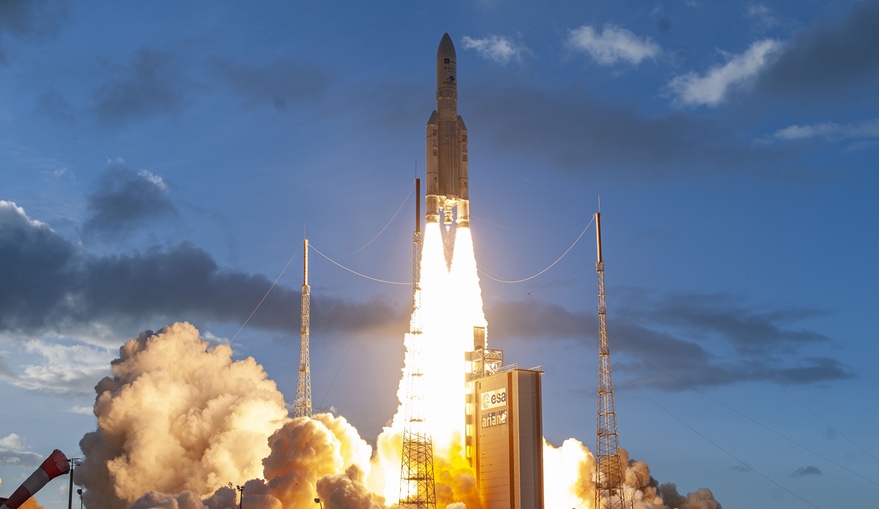ORLANDO — An Ariane 5 successfully launched two commercial communications satellites July 30 in the first flight of the rocket in nearly a year, and the first of two missions before it launches a NASA space telescope.
The Ariane 5 lifted off at 5 p.m. Eastern time from the spaceport in Kourou, French Guiana. The rocket’s upper stage deployed the Star One D2 satellite 30 minutes after liftoff and the Eutelsat Quantum satellite six minutes later, both into geostationary transfer orbits.
Star One D2 is a Maxar-built satellite for Brazilian operator Embratel Star One. The 6,190-kilogram satellite carries a payload of C-, Ka-, Ku- and X-band transponders that will serve a variety of applications, from broadband service in Central and South American to government communications over the Atlantic. The spacecraft will operate from 70 degrees west in GEO.
Eutelsat Quantum was built by Airbus Defence and Space for Eutelsat through a public-private partnership with the European Space Agency. The 3,461-kilogram satellite, based on a platform developed by Surrey Satellite Technology Ltd., is the first commercial satellite with a “fully flexible” software-defined payload, allowing its spot beams to be reconfigured to meet changing markets. Eutelsat will initially operate the satellite at 48 degrees east in GEO to provide Ku-band service in the Middle East and North Africa.
“I am happy for my customers,” Stéphane Israël, chief executive of Arianespace, said on the webcast after the company confirmed the mission’s success. “It’s very important for Arianespace since it was the first Ariane 5 of the year. It had to be a success and, tonight, it’s a great success.”
The launch was the first for the Ariane 5 since Aug. 16, 2020, when the vehicle launched two communications satellites and Northrop Grumman’s Mission Extension Vehicle 2. This was only the fourth Ariane 5 launch since the beginning of 2020, an unusually slow pace for a vehicle that had been a mainstay of the commercial launch market.
The Ariane 5 had effectively been grounded for months since that August 2020 launch. In May, Arianespace confirmed that launch, as well as the previous one in February 2020, suffered “a less than fully nominal separation” of the payload fairing. In neither incident were any of the payloads damaged, but Arianespace postponed launches to investigate the issue with the fairing manufacturer, Ruag.
At the time Arianespace said that the efforts of Ruag and the Ariane 5 prime manufacturer, ArianeGroup, “remains positive,” but the companies did not comment further on the problem.
The issue raised concerns because of the upcoming launch of the James Webb Space Telescope on the Ariane 5. ESA is providing the launch of the $8.8 billion spacecraft as part of its contribution to the mission, in exchange for a share of observing time.
The launch is the first of two of the Ariane 5 before the high-profile launch of NASA’s James Webb Space Telescope. Thomas Zurbuchen, NASA associate administrator for science, attended the launch in French Guiana and met with ESA and Arianespace officials to discuss preparations for the JWST launch.
Neither NASA nor ESA have announced a launch date for JWST, beyond a launch readiness date of Oct. 31. NASA officials have previously said that they estimated JWST would launch about four months after this Ariane 5, based on a cadence of one Ariane 5 launch every two months, which would mean a launch no earlier than late November.
